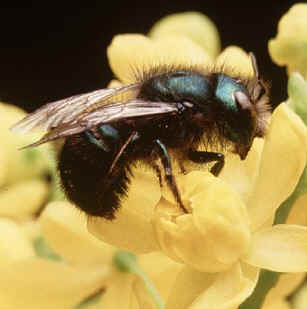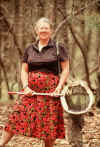![]()
Pollinator Paradise Pollination
Ecology at UI The
Solitary Bee Web
Rearing Solitary Bees
Suppliers References
Bee Gardens FAQ
Links Contact
Us
New Mexico Native Bee Pollinator Project About
Dr. Strickler
Bee Nests and Accessories Bee Photo
Gallery
![]()
Table of ContentsIntroduction
Osmia ribifloris on barberry flower.
|
 |
|
A slightly different version of this article was printed in the April 1997 edition of Pennsylvania Fruit News. It is posted here with permission.
Contrary to our usual idea that "bees" live in hives, with queens, workers, and drones, most bees cannot be hived, are not social, don't store honey, and rarely sting. The introduced, European honey bee is a highly specialized exception, rather than a representative "bee." There are about 3,500 species of bees in North America, and over 20,000 bee species worldwide. Most species of bees (Apoidea) are active as adults for only a few weeks annually. The rest of the year, they live in their nests as larvae, pupae and dormant adults. Their active periods coincide with the times during which their preferred floral hosts bloom. Thus, during the course of every growing season, a series of different bee species appears and vanishes seasonally. About 85 % of all bees are solitary. This means that every female bee mates, makes a nest with about 10 brood cells, stocks each cell with a nectar and pollen mixture as food for her larvae, lays an egg in each, and dies before her young emerge. Although individual bees are solitary, nesting females may make their nests close together, forming aggregations that can include millions of nests and bees. Most species of bees dig nests and cells underground, and waterproof their brood cells with secretions from abdominal glands, including polyesters. Others make cells of mud, neatly-cut bits of leaves, resin, plant hairs, wood dust, or silk secreted from thoracic glands. They are placed in hollows in reeds, bamboo, logs, pithy stems, softwood structures, dry adobe, and other materials (Batra 1984).
Species of gregarious solitary bees that will nest in vast aggregations have some common traits: they are naturally active at the time that a crop blooms, favor this crop's flowers, can reproduce on a diet of nectar and pollen from the crop, and are ideal candidates for management as pollinators to augment our rapidly declining honey bees, on which we have become dependent. Beekeepers and growers are becoming enthusiastic about using solitary bees, which are resistant to parasites and diseases of honey bees, are gentle, easy to manage, and cannot breed with Africanized bees. Although the versatile honey bee is a satisfactory pollinator for many crops, other bee species can be used in orchards. Selected solitary bees are easy to keep because they are far gentler than honey bees or bumble bees, and their period of adult activity coincides with bloom. After the flowers have been pollinated, the adult bees die and manageable species of bees (as dormant brood) can be put away into storage until the next year's pollination season when the next generation of adult bees emerges. This contrasts with the social honey bees which need more attention because they must feed from flowers and honey stores in order to stay warm and active year-round.
Natural, unmanaged pollination may be adequate in small orchards that are surrounded by forests and meadows if native pollinators are protected from pesticides and suitable nesting sites for underground-nesters, such as bare, south-facing, sun-catching, sandy, dry banks or slopes are available. Shelter belts of trees to break the cold northwest wind would also encourage native bees to nest, since they prefer warm soil. Bees that belong to the genera Andrena, Colletes, and Dialictus are major pollinators under these conditions. Because these bees fly only short distances from their nests to forage, they don't provide adequate pollination in large, intensively managed orchards; thus honey bees and other pollinators must be used.
The most useful pollinators of fruit trees should meet criteria relating to their host preference, foraging behavior, life cycles, manageability, and nesting habits, as follows:
Several species of mason bees (genus Osmia) have been used for orchard pollination worldwide. In Europe, O. rufa and O. cornuta are used. The orchard mason bee, Osmia lignaria, is used in North America. The hornfaced bee, Osmia cornifrons, is the first solitary bee to be used on a large commercial scale to pollinate crops. Techniques to manage it were developed by Japanese apple growers about 50 years ago, because it is an efficient pollinator and is easy for growers to maintain (Maeta 1990). These bees were first imported from Japan to Utah in 1965, but they did not survive there. In 1976, they were imported into Maryland, where they throve in a climate that resembles that of central Japan (Batra 1979).
For the past 15 years, in late winter, I have sent "starter kits" of hornfaced bees, including instructions and materials for nests, to growers, beekeepers, scientists, extension agents, schools, and nature study centers in many states. The bees have survived best in humid parts of USDA Plant Hardiness Zones 5 to 8. Because these bees are so efficient, only about 600 female bees are needed per hectare of orchard; this compares favorably with the usually recommended two hives of honey bees (with tens of thousand of workers) per hectare. Hornfaced bees strongly prefer the flowers of Rosaceae, and, unlike honey bees, they are not readily distracted by dandelions and other weeds. An individual hornfaced bee is 80 times more effective than an individual worker honey bee for pollination of apples (Maeta 1990).
The native orchard mason bee, Osmia lignaria, can be used to pollinate fruit trees (Torchio 1976). These dark blue bees can survive colder and drier climates than can hornfaced bees. Orchard mason bees are commercially available, but it is important to obtain bees from suppliers that are located in climatic zones where the bees are to be used. These bees also can be collected locally by placing "trap nests" where the bees already live. Some bees will eventually move into the trap nests, which can be placed into orchards the following year. Trap nests are dry wooden blocks, posts, or logs that have been drilled with smooth-walled, 5/16" x 4-6" holes. Orchard mason bees can be kept together with hornfaced bees for pollination.
Following the usual precedents and procedures involving the importation of exotic solitary bees for pollinating our exotic crops, a Japanese solitary bee, Anthophora pilipes villosula, (the shaggy fuzzyfoot bee) was introduced at Beltsville, where it was tested on several crops (Batra 1994). It is a superior pollinator of blueberries in Japan, and the European subspecies of this bee has been managed to pollinate fruit trees (Thalmann & Dorn 1990; Thalmann 1991). The period when adult bees are naturally active coincides with the bloom of blueberries, peaches, apples, pears, plums and cherries, all of which this bee visits. The fast-flying, long-tongued, solitary bee is active from dawn to dusk, and during cool, rainy weather when other bees don't fly. Like bumblebees, it generates body heat. A single female can visit some 337,000 flowers during her lifetime in order to obtain enough nectar and pollen to stock her brood cells and for her own energy needs. She also uses nectar to make the oily secretion that she uses to line her brood cells and feed her larvae; she drinks the nectar that she spits out to soften the dry adobe where she digs her nest and brood cells. It is easy to manage this species, because it will nest in portable and stackable dry adobe blocks. The bees have a strong homing instinct, thus they do not tend to leave the area or "drift." It would be practical to set up inexpensive, permanent bee shelters containing adobe blocks for this bee, placed near orchards. I use surplus calf hutches, large garbage cans, and clean oil drums as ready-made, inexpensive shelters to keep the adobe dry, . These shelters also shade the nesting bees, and make them less visible to predatory birds. These bees are suitable for humid parts of USDA Plant Hardiness Zones 7 (with winter protection) to 9. Field trials in the southeastern states are planned.
Two approaches can be taken to enhance the pollination of orchards by solitary bees. The first approach would be to manage the habitat in and around them to provide nesting sites for whatever native pollinators reside in the area. Small or narrow plots are preferable to large, wide ones, because they allow bees to reach their centers. If Andrena and Colletes are present, populations of most species may be increased by making sunny, south-facing sand banks and removing shady vegetation from any existing nest aggregations. Bees that nest in holes in wood would benefit from brush piles and wooden blocks or structures with suitably sized pre-drilled holes placed in sunny areas around the orchards. Habitat management may take up too much space and thus be too costly; it may also interfere with mechanized operations, or it may provide refuges for crop pests.
The second approach would be to maintain populations of selected species in bee shelters that are strategically placed in or near the orchards. Solitary bees can be kept in shelters using inexpensive man-made nesting materials; they do not need much space, will not interfere with most operations, and will not harbor crop pests. After bloom, such bees can be removed from the orchards and put into storage for the rest of the year. This permits subsequent pesticide applications, cultivation, and harvest, without any loss of these pollinators.
Batra, S. W. T. 1979. Osmia cornifrons and Pithitis smaragdula, two Asian bees introduced into the United States for crop pollination. Proc. IV Internat. Symp. Pollination, Maryland Agric. Exp. Sta. Spec. Misc. Publ. 1:207-312.
Batra, S. W. T. 1984. Solitary bees. Scientific American 259:120-127.
Batra, S. W. T. 1994. Anthophora pilipes villosula Sm. (Hymenoptera: Anthophoridae), a manageable Japanese bee that visits blueberries and apples during cool, rainy, spring weather. Proc. Entomol. Soc. Washington 96:98-119.
Maeta, Y. 1990. Utilization of wild bees. Farming Japan 24:13-19.
Thalmann, U. 1991. Ausgewahlte Untersuchungen zur Reproduktionsbiologie der SolitarbienenArten Anthophora acervorum (Linne 1758), Osmairufa (Linne 1758). Ph.D. Dissertation. Martin-Luther-Universitaat, Halle-Wittenberg, 1-121.
Thalmann, U. and M. Dorn, 1990. Die Haltung der Pelzbiene, Anthophora acervorum (L.), und ihr Einsatz zur Nutzpflanzenbestaubung. Wissenschaftliche Zeit. Martin-Luther-Universitat, Halle-Wittenberg 39:15-21.
Torchio, P. F. 1976. Use of Osmia lignaria Say (Hymenoptera: Apoidea, Megachilidae) as a pollinator in an apple and prune orchard. Joumal of the Kansas Entomological Society 49:475482.
|
 |
![]()
Top of Page
Pollinator Paradise
Pollination Ecology at UI
The Solitary Bee Web
Rearing
Solitary Bees Suppliers
References Bee
Gardens FAQ Links
Contact
Us
New Mexico Native Bee Pollinator Project About
Dr. Strickler
Bee Nests and Accessories Bee Photo
Gallery
![]()